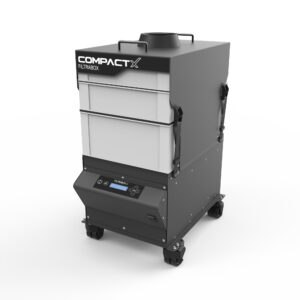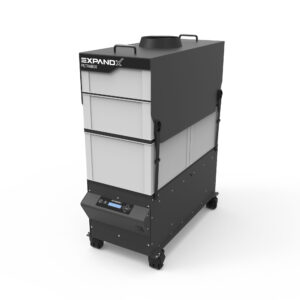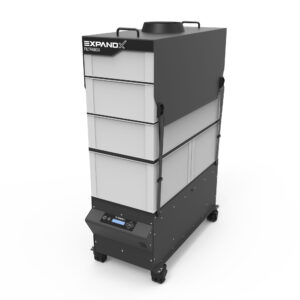Fume Extraction For Dye Sublimation Printing

Using a wide-format inkjet printer, dye-sub inks are printed on a special transfer paper or directly onto fabric. From there, the image is heat transferred into the fibers of the fabric by using a heat press. The ink changes from a solid to a gas (hence the term “sublimation”) and is fixated deep into the fibers of the fabric and returns to a solid-state. The dye pigments are carried by a glycol-based solvent which is evaporated off the fabric during the heating process. This generates a fog made up of tiny liquid glycol particles which can cause irritation to the eyes, nose, and throat.
You can protect yourself by using a fume extractor that captures the and tiny liquid particles. The pre-filter and HEPA filter capture the fine particles while the gas filter captures the odors.
Dye Sublimation Printing Fume Extraction
Roll to roll dye sublimation printing can be done in two ways. A wide format printer is used to apply dye-sub inks onto special transfer paper or directly onto fabric. When using transfer paper, the printed paper and the virgin fabric are pressed together between heated rollers, also known as a rotary heat press. The heat transfers the ink from the paper onto the fabric. The heat turns the ink into a gas which then re-solidifies and becomes permanently affixed onto and within the fibers of fabric. When printing directly onto fabric, the rotary heat press does the same thing, but without the intermediary step of printing onto the transfer paper. The roll-to-roll process allows one to produce large, continuous lengths of dye-sublimated fabrics. Consequently, a large amount of ink is consumed in this process.
The dye pigments are carried by a glycol-based solvent which is evaporated off the fabric during the heating process. This generates a dense fog made up of tiny liquid glycol particles which can cause irritation to the eyes, nose, and throat. Given that the process uses high volumes of dye and solvents, the fog can easily overwhelm a workspace. The fog droplets can also settle on the printing equipment and surfaces (walls, furniture and floors) within the room, leaving an oily residue that can be staining and slippery. Using a specialized dye-sublimation fume extractor to remove the fog, directly from the source, can keep the workplace cleaner and safer.
Our dye-sublimation fumes extractors employ a three-stage filtration process to remove the fog. The water and tear-resistant prefilter remove larger fog particles to allow the Hydrophobic HEPA filter to more efficiently remove the finest of the fog droplets. Some fabrics have specialized coatings to promote ink adherence which can off-gas odors when heated. The final stage of filtration within the filtered fume extractor is an activated carbon filter, which captures the odors through a process called adsorption. Adsorption is the ability of the activated carbon to attract and hold odor/gas molecules on its surface. Activated carbon has an extreme amount of surface area within its micropores and macropores.
Consider using the Filtrabox Dye Sublimation fume extractor for existing or new dye sublimation projects. Ask us about custom connection kits for retrofit or new OEM applications.
Frequently Asked Questions
Your Title Goes Here
Your content goes here. Edit or remove this text inline or in the module Content settings. You can also style every aspect of this content in the module Design settings and even apply custom CSS to this text in the module Advanced settings.
What is the primary purpose of a laser fume extractor?
The primary purpose of a laser fume extractor, like Filtrabox's model, is to capture the fumes generated during laser engraving, cutting, or marking and recirculate purified, clean air back into the work environment. This improves indoor air quality and ensures a safer workspace.
What are laser fumes made up of?
Laser fumes comprise two primary components: respirable dust and volatile organic compounds (VOCs).
Are simple dust collectors sufficient for handling laser fumes?
No, simple dust collectors are not enough. A comprehensive fume extraction solution designed explicitly for laser fumes is required.
What kind of lasers generate respirable dust?
All laser marking, engraving, and cutting systems—including CO2, fiber, and YAG lasers—generate respirable dust.
What is the risk associated with respirable dust?
Respirable dust particles are so small (2.5 microns and less in diameter) that they can penetrate deep into the lungs and pose increased health risks.
How effective are Filtrabox's HEPA filters?
Filtrabox uses high-performance HEPA filters tested at H14, which is 99.99% at 0.3 microns. It captures virtually all respirable dust particles, producing extremely clean air.
Can the dust particles be seen with the naked eye?
Given their small diameter, individual dust particles are usually invisible to the naked eye but can often be seen as smoke in high concentrations.
Why is a three-stage, high-efficiency filter arrangement important?
A three-stage, high-efficiency filter arrangement ensures comprehensive capture of respirable dust and VOCs, making the air dust-free and free from harmful organic compounds.
Is Filtrabox's fume extractor suitable for all laser applications?
Filtrabox's fume extractor is excellent for all laser applications, including engraving and cutting.
How does a fume extractor like Filtrabox improve indoor air quality?
By capturing laser fumes directly from the source and recirculating purified, clean air back into the work environment, Filtrabox's fume extractor significantly improves indoor air quality.





